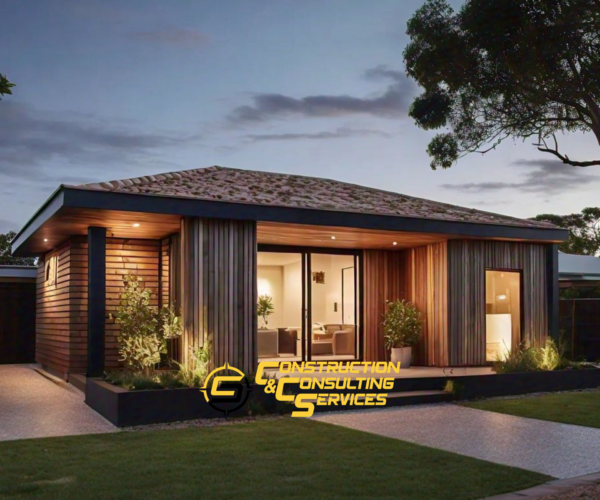The demand for guesthouses in Los Angeles is on the rise, you might interested building a guesthouse due to various factors such as growing families needing more space within their existing homes or homeowners seeking rental income opportunities. Homeowners have to face challenges in constructing guesthouses due to stringent zoning laws and building codes. However, recent updates to regulations in California have eased these restrictions, allowing many homeowners to legally add additional living spaces to their properties.
Guesthouses, known by various names like accessory dwelling units (ADUs), granny flats, or backyard cottages, offer versatile utility, which is a significant advantage of their construction. ADUs not only serve as a potential source of extra income for homeowners but also provide affordable housing options for tenants. Additionally, they contribute to the controlled densification of single-family areas, offering a viable alternative to the development of new apartment complexes.

Why Build a Guest House or ADU on Your Property?
Recent regulatory changes have sparked excitement among homeowners, offering them the opportunity to easily add living space to their existing properties for a multitude of purposes. Prior to these regulatory adjustments, creating additional space often necessitated building another story, a costly and labor-intensive endeavor that frequently involved significant alterations to the home’s layout. Constructing an ADU alleviates many of these challenges while providing homeowners with unparalleled flexibility in usage.
What Kind of Guest Houses are There?
There are two primary options for constructing a guest house on your property. You can either build an independent unit in the backyard or convert an existing garage into a guest house. Converting a garage offers substantial cost advantages since the basic structure is already in place. An average-sized garage typically occupies 300-400 square feet, providing ample space for a studio apartment complete with a kitchen and bathroom.
Constructing an independent unit offers immense flexibility and can take various forms, but it is restricted to two stories with a maximum height of 25′. Additionally, it must be situated at the rear of the lot and is limited to 1200 square feet.
Who Can Build an ADU?
Wondering if you can build a guest house on your property? The city of Los Angeles permits the construction of guest houses on nearly all residentially zoned properties with existing homes. When converting an existing garage into a guest house, two parking spots must be maintained for the existing residence, which can be arranged side-by-side or in tandem.
The new unattached guest house must be at least 10 feet away from the existing house and garage, and at least 5 feet from both the rear and side property lines. However, a garage converted into a living space is exempt from these setback requirements.
There are no parking requirements for properties located within one-half mile of public transit.
For homeowners considering the construction of a guesthouse or an accessory dwelling unit on their R-1 lot, thorough research and careful planning are essential before proceeding with their plans. Not sure if your lot is eligible for an ADU? You can enter your address and find if your property is eligible
What is the Process of Building a Guest House?
The process typically begins with the homeowner consulting a certified and experienced contractor, providing details about lot size, existing structures, design preferences, and budget. Once the basics are agreed upon, an architect or plan designer is brought in to prepare the plans. After finalizing and approving the plans, the contractor submits a detailed quotation. Upon signing a work agreement, the contractor submits the plans to the building department for final approval before commencing the project.
How Much Does It Cost To Build A Guest House?
Cost of building a guest house varies greatly based on the lot size and construction options selected. You can find in our website the full guide about building costs: Read More The Full Building Cost Guide in Los Angeles
Or use this ADU building cost calculator
CCS Inc is a design to build company known as the best guest house contractor that serving the greater Los Angeles area for decades. With our in-house design team and dependable construction division, our company effectively presents guest house ideas that fit to your needs and executes the construction as illustrated in the floor plans.
What Are The Differences Between ADUs and Guesthouses
In the realm of home expansion and property development, two terms often pop up: Accessory Dwelling Units (ADUs) and guesthouses. While they both serve the purpose of providing additional living space, they differ in various aspects, from their design and construction to their legal requirements and potential uses. In this blog post, we delve into the nuances that set ADUs and guesthouses apart, helping you understand which option might suit your needs best.
Understanding ADUs:
ADUs, also known as granny flats, in-law units, or secondary suites, are self-contained living units that exist on the same property as the main residence. They can either be attached to the primary dwelling, such as a converted basement or garage, or built separately, like a standalone cottage in the backyard.
Key Features of ADUs:
- Independence: ADUs have their own entrance, kitchen, bathroom, and living space, offering a degree of independence from the main house.
- Legal Status: In many jurisdictions, ADUs must comply with specific zoning and building regulations. However, recent changes in regulations in various areas have made it easier for homeowners to build ADUs on their properties.
- Versatility: ADUs can serve multiple purposes, including housing elderly relatives, providing rental income, or accommodating guests.
- Construction: Building an ADU often requires approval from local authorities and may involve more extensive construction work, especially if it’s a standalone unit.
Exploring Guesthouses:
Guesthouses, on the other hand, are typically separate structures built on the same property as the main house. They are specifically designed to accommodate guests and may offer more amenities than traditional ADUs.
Key Features of Guesthouses:
- Purpose-Built: Unlike ADUs, which can have various uses, guesthouses are primarily intended to house visitors or guests.
- Design: Guesthouses often feature amenities similar to those found in hotels, such as multiple bedrooms, bathrooms, and living areas, making them ideal for extended stays.
- Legal Considerations: Like ADUs, guesthouses must comply with local zoning laws and building codes. However, they may have different regulations depending on their intended use and design.
- Construction: Building a guesthouse may involve more customization and luxury features compared to ADUs, potentially resulting in higher construction costs.
Choosing Between ADUs and Guesthouses:
When deciding between ADUs and guesthouses, several factors come into play, including your budget, space requirements, and intended use. If you’re looking for a versatile living space that can serve multiple purposes, an ADU might be the way to go. On the other hand, if you want to provide luxurious accommodations for guests or family members, a guesthouse could be the ideal solution.
In conclusion, while both ADUs and guesthouses offer additional living space, they cater to different needs and preferences. By understanding their differences and weighing the pros and cons of each option, you can make an informed decision that aligns with your goals and aspirations for your property. Whether you opt for an ADU or a guesthouse, both choices have the potential to enhance the functionality and value of your home.



